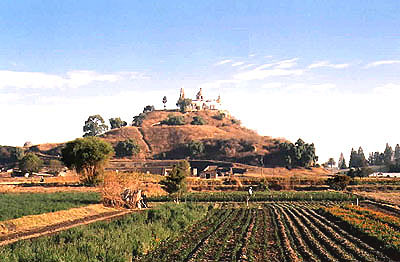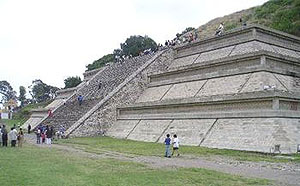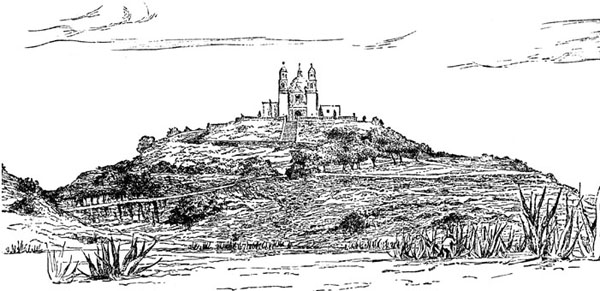Mexonline.com

|
|
|
|
THE GREAT PYRAMID OF CHOLULA, Cholula, Puebla
|
|
For more information on Cholula and Puebla, see The Puebla City Guide
 |
|
Cholula Pyramid and
La Iglesia de los Remedios, Cholula | |
Located on the central plateau of Mexico, hidden to the naked eye, sits the world's largest ancient pyramid. The town where this wonder is located is Cholula, a small village just outside Puebla. Upon first glance, one sees only the charming colonial church of La Iglesia de los Remedios, built in the 16th century. Amazingly, however, this church sits atop the Great Pyramid of Tepanapa, oftentimes referred to as the Cholula Pyramid. Hidden by vegetation, the hill upon which the church was built, actually houses the great pyramid.
The history of the pyramid, coupled with the momentous events which followed, is full of drama and mystery. Approximately one hundred years before Christ, the pyramid's construction begun. Cholula, by this time, was already one of Mexico's largest cities, having been settled circa 1700 B.C.
The pyramid's construction along with affiliated temples, was carried out by various groups over hundreds of years. Its early period coincided with the great city of Teotihuacan's development and power.
 |
|
Inside Cholula Pyramid | |
An important ceremonial and political center of the pre-Columbian world, Cholula mirrored Teotihuacan's glory days of power. As well, its first subsequent demise coincided with that of Teotihuacan. But unlike the great city to the northwest, whose people mysteriously disappeared, some residual peoples remained in Cholula, not abandoning the city entirely. Expansion of the pyramid continued with the arrival of the Olmec-Xicallancas, who further added to the pyramid's scale.
The Toltec-Chichimecas occupied Cholula next, circa 1100 A.D. By that time the great pyramid was already largely submerged underneath tree and dirt. The Toltecs chose to focus their activity on building new temples which would surround the area of the great pyramid. The Toltecs also brought with them their intense devotion of Quetzalcoatl. Cholula subsequently became a mecca for pilgrims from all over Mexico, who flocked to the city to pay homage to the feathered serpent God.
Quetzalcoatl, already a long established deity of the Mesoamerican world, undoubtedly helped to inspire the pyramid's initial construction. However, with the arrival of the Toltecs, the cult of Quetzalcoatl truly flourished. Additionally, under the rule of the Toltecs, Cholula became a major center for trade and commerce. Having established strong ties with all other cities in the region, Cholula maintained its independence for a time from the ever expanding Aztec Empire.
However, the Aztecs eventually took control of Cholula. When Cortes arrived in 1519, the pyramid, stood silent, hidden under grass and stone. The city's population at this time equaled 100,000 inhabitants. Legend advises an ambush was planned by the Cholulans against the Spanish invaders under the direction of Montezuma. No longer swayed by Cortes whom he initially believed to be the reincarnation of Quetzalcoatl, the Aztec ruler made one last attempt to save his empire. Unfortunately, Cortes learned of the plan and what followed next was horrific: the slaughter of 6,000 Cholulan residents took place under the brutal command of Cortes.
 |
|
Restored Stairway Cholula Pyramid | |
Temples were torn down and the ancient city of Cholula was destroyed. Cortes proclaimed that he would build a church in the area for each day of the year to match the number of temples destroyed. Drunk with power and with gold on his mind, Cortes failed to see the great pyramid.
Centuries elapsed before the pyramid was again discovered. In 1910, construction began on an insane asylum located at the base of the pyramid. Archaeologists once aware of the site began to survey and excavate. In the 1930's, tunnels were made in order to better study the pyramid. These tunnels, which amount to an amazing five miles worth of passageways, zigzag in subterranean fashion, creating a labyrinth, not for the timid. These tunnels afford the visitor the opportunity of observing first-hand the various levels of construction. Delineated layers of shell and stone are visible. A total of four stages of construction occurred, over hundreds of years. Although lit with lamps, the atmosphere is definitely haunting and you most assuredly want to exit before nightfall.
In addition to the tunnels, outside there are altars, stairways and platforms to explore. One can also see a portion of the pyramid which was reconstructed by archaeologists. Not only does the pyramid of Cholula represent the largest single structure in Mexico, it also bears the distinction of having the largest base of any pyramid in the world, exceeding the bases of the great pyramids in Egypt. The total acreage the pyramid occupies is 25 acres with a height reaching an impressive 181 feet. Each side of the structure's base is over 1300 feet in length.
When visiting the great pyramid of Cholula one is also afforded a magnificent view of the majestic snow-capped El Popocatepetl and Iztaccihuatl volcanoes. The pyramid of Cholula is truly a wondrous pre-Columbian gem. The site holds the potential of even greater discoveries and with only a small portion yet excavated, who knows what marvelous secrets the great pyramid has yet to reveal.

|
|